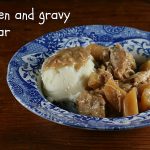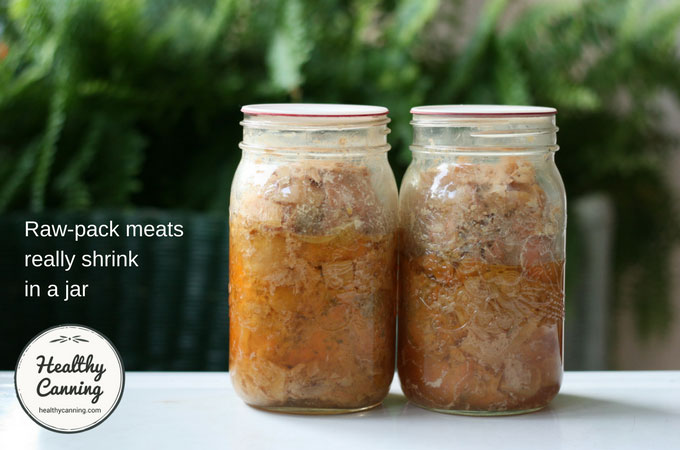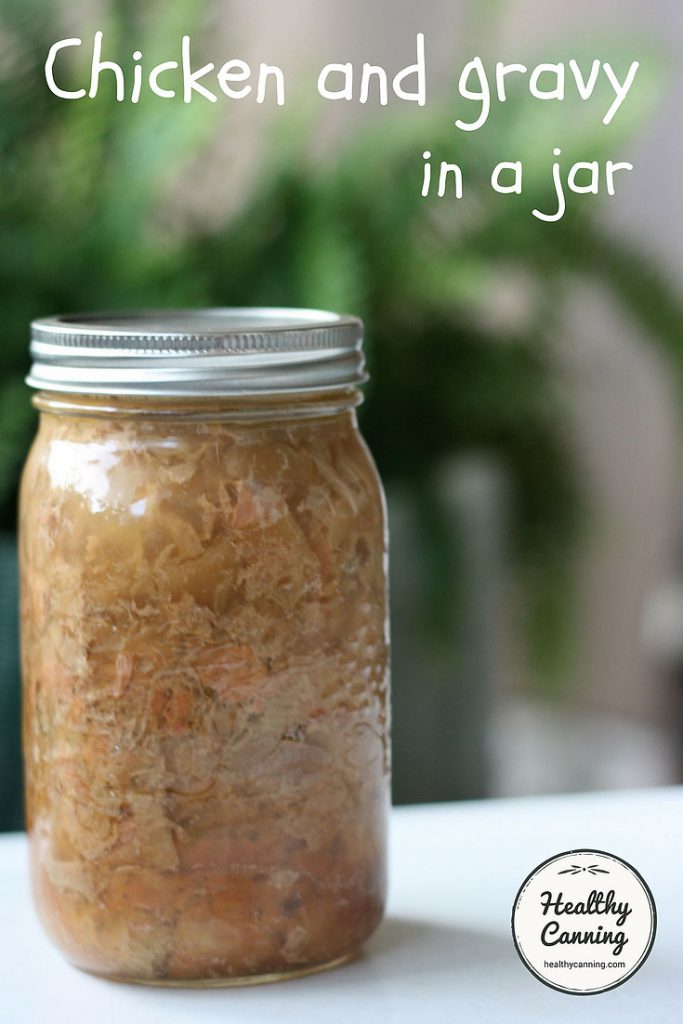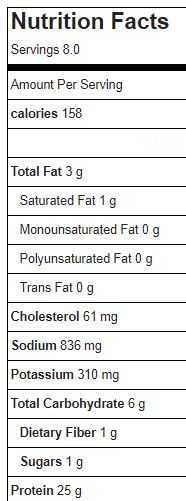This Chicken and Gravy in a jar forms the basis for a wonderful chicken dinner.
The name is actually a bit misleading: you actually make the gravy after you open the jar.
In any event, this smells wonderful. It will make the kitchen smell like a good old-fashioned Sunday roast dinner with all the trimmings. People will salivate.
The prep work for canning is also really fast: the entire mixture is raw pack.
This recipe comes from the Ball All New book (2016).
You may wish to double or triple this recipe to get a full canner load: if so, just do your calculations on paper first before proceeding so that you aren’t trying to do mental gymnastics in the thick of things.
The recipe
Jar size choices: Half-litre (US pint / 16 oz) OR litre (US quart / 32 oz)
Processing method: Pressure canning only
Yield: 2 x litre (US quart) jars
Headspace: 3 cm (1 inch)
Processing pressure: 10 lbs (69 kPa) weighted gauge, 11 lbs (76 kpa) dial gauge (adjust pressure for your altitude when over 300 metres / 1000 feet.)
Processing time: Half-litres (pints) 75 minutes; litres (quarts) 90 minutes
If you don’t have a pressure canner, you could freeze this in plastic containers or straight-sided jars with no shoulders. (Water-bath canning is not acceptable for safety reasons.) Cook when you thaw it.

Chicken and Gravy in a Jar
Ingredients
- 175 g onion (chopped. 1 cup / 6 oz)
- 125 g celery (finely chopped. 1 cup / 4 oz )
- 175 g potato (peeled, diced. 1 cup / 6 oz)
- 1 kg chicken (boneless. 2 lbs)
- 2 teaspoons salt (OR non-bitter, non-clouding salt sub)
- 2 teaspoons poultry seasoning
- 1 teaspoon ground black pepper
- 4 tablespoons white wine (dry. 50 ml / 2 oz)
- chicken stock (or water, to fill jars. See recipe notes)
Instructions
- Wash, peel, chop onion. Add to large bowl.
- Wash, chop celery. Add to large bowl.
- Wash, peel, dice potatoes. Add to large bowl.
- Cut chicken into 5 cm (2 inch) chunks. Add to large bowl.
- Add all remaining ingredients except broth to bowl.
- Put a kettle or pot of water on to boil for you to make your chicken broth from, if you are using bouillon cubes, powder or liquid. If you're using home-made, start heating it in microwave. Mind the surge when you remove it.
- Using your clean hands or a very sturdy spoon, mix the contents of the bowl.
- Jar size choices: half-litre (1 US pint) or 1 litre (US quart)
- Pack the hot jars firmly (but not overly tightly) with mixture.
- Leave 3 cm (1 inch) headspace.
- Top up the jars with hot chicken broth.
- Debubble; adjust headspace.
- Wipe jar rims.
- Put lids on.
- Processing pressure: 10 lbs (69 kPa) weighted gauge, 11 lbs (76 kpa) dial gauge (adjust pressure for your altitude when over 300 metres / 1000 feet.)
- Processing time: half- litre (1 US pint) 75 minutes; 1 litre (US quart) 90 minutes.
Nutrition
Reference information
How to pressure can.
When pressure canning, you must adjust the pressure for your altitude.
For salt substitute, Herbamare Sodium-Free was used.
Storage life of home canned goods
Recipe notes
- To be clear, you don’t heat or pre-cook the mixture before packing it in jars. This is a raw pack. Ball says, “These easy raw pack recipes are an innovative way to create delicious ready-to-eat meals for your pantry all year long. Raw ingredients and seasonings are combined, packed in the jar, and covered with hot broth; all of the cooking takes place right in the jar! Note: To ensure proper pressure and temperature is achieved for safe processing, you must process at least 2 quart or 4 pint jars in the pressure canner at one time.”
- As this is a raw pack, there are two points we want to bring to your attention:
- (1) Raw packs can sometimes stick to the insides of jars a bit, so wide mouth jars if you have any available can be easier to clean.
- (2) As this is a raw pack, there will be shrinkage during processing. Thus they want you to pack the jar “tightly.” But that doesn’t mean squish it down, either. In fact, we’re going to suggest you consider packing it not quite so tight. Raw pack meat, and particularly poultry, really contracts when it is processed. The result is that it will shrink in the jar, leaving you with a huge amount of air space in the jar even if no venting of liquid occurs from the jar. That was our experience in round one (see photo below.) Better you should pack it, we think, not quite so tightly, and leave a bit more room in the jar from more broth, which will stay in the jar and help prevent the exposed meat darkening in the jar.
- How much broth or water to fill the jars? Ball doesn’t give any amounts. It all depends on how the chicken is packed in the jars. Per loose-packed batch, you may not need more than 1 to 2 cups (250 to 500 ml / 8 to 16 oz), if that even. If you do pack it as tight as they seem to suggest, then you might get no more than a couple tablespoons of broth / water in per jar.
- You can multiply the recipe as many times as you want. Just do the math first and write it down on paper, and work from that.
- A food processor is ideal for the celery and onion, but do the chicken by hand, and probably the potato, too, unless you have a miraculous dicing gizmo.
- Note finely chopped means finely “chopped”, not so small as to be called “minced.”
- If you don’t have poultry seasoning, instead of the 2 teaspoons use: ½ teaspoon dried rosemary, ½ teaspoon dried thyme, ½ teaspoon dried marjoram, ½ teaspoon dried sage (yes, there is sage in poultry seasoning.)
- Instead of dry white wine, you could use any white wine, or white vermouth, or white Dubonnet, or a rosé wine or a very pale sherry. (You probably wouldn’t want red wine, wrong colour for chicken.) Or, omit. It’s just there for flavour. Don’t use white wine vinegar — you don’t want pickled chicken for supper.
- You can use any kind of boneless chicken you wish (e.g. thigh). It will affect the nutrition, raising calories and fat level, if that matters to you.
- Ball says “dice the potatoes.” In cooking vocabulary, there’s actually a small, medium and large dice. Ball doesn’t say which. We opted for “large dice”, which is 2 cm x 2 cm x 2 cm (¾″ x ¾″ by ¾″).
- You can reduce or omit the salt, which is just there for seasoning, and add it instead if you wish at the table.

If you pack it reasonably tightly, this is the kind of shrinkage you may experience. For that reason, we’re suggesting maybe firmly but not all that tightly — leave room for a bit more broth instead.
Usage notes
Transfer contents of jar to a microwave safe jug, or to a pot. Stir in 1 tbsp flour for half-litre (pint) jars; 2 tablespoons of flour for litre (quart) jars.
- Microwave: zap for a minute, stir, then zap for a few more minutes until heated.
- Stove-top: bring to a simmer over medium-heat, stirring frequently to ensure that flour doesn’t form lumps as it thickens.
Serve with all the trimmings: mash, veg, etc. Even boxed stuffing / dressing (Stove Top or Paxo) is a welcome addition on a weeknight.
Recipe source
Butcher, Meredith L., Ed. The All New Ball Book of Canning and Preserving. New York: Oxmoor House. 2016. Page 275.
Modifications: none

The potatoes will turn golden but that’s because they have absorbed chicken juices.
Nutrition
Serving size: 1 cup (250 ml)
Based on skinless, boneless chicken breast.
Note: does not include thickener. Nor any possible sodium from the broth for that matter. Allow for that in your mind as well if that matters to you, unless you made your own from scratch salt-free.
Regular version (with salt)
Per 1 cup (250 ml): 158 calories, 836 mg sodium
Weight Watchers PointsPlus®: 4 points+ (3 SmartPoints)
Salt-free version
Per 1 cup (250 ml): 158 calories, 267 mg sodium
All other nutrition information same as above.
* Nutrition info provided by https://www.myfitnesspal.com
* PointsPlus™ and SmartPoints™ calculated by healthycanning.com. Not endorsed by Weight Watchers® International, Inc, which is the owner of the PointsPlus® registered trademark.



martha vickers
IS THAT 2LB.S RAW CHICKEN OR 2LB.S COOKED CHICKEN?
kathy
can you partially cook the chicken so there’s not so much shrinkage?
Healthy Canning
You’d need to ask Ball that question directly, if it will affect the heat diffusion in the contents or not. (Cooked meat is denser.)
Teresa
Can you leave the potatoes out?
Healthy Canning
We are leery of answering yes, because, while of course you can, some people’s next question is going to be, okay then can you add more chicken to make up for that? So we are going to say, “ask Ball” because they developed the recipe. They are very responsive to questions on their FB page.
Kathy
Can I use bone in thighs? Would I need to cut some of the meat off to make them smaller?
Healthy Canning
Ask Ball directly if they have any concerns about using bone-in thighs. (If they don’t, you might still want to alert people that there might be small bones in the mixture they are being dished up.)
Joan Audino
Can I use thighs, or a mix of thighs and breasts?
Healthy Canning
Thighs would be fine. You would probably want to make sure they were boneless for safety at time of consumption, so people aren’t picking bones out of their food.
Susan Williams
NCHFP changed the headspace for canning raw chicken to 1 1/4″. Should this be updated?
https://nchfp.uga.edu/how/can_05/chicken_rabbit.html
Healthy Canning
No. Ball tested the indicated headspace for this recipe.
Katherine Herron
This was so very delicious that I am making another batch! Thanks for posting this.
Katherine Herron
Oh my goodness. I wasn’t sure what to expect with this but I finally opened a jar and it was delicious! Thank for this recipe!
Nancy Lee Haslam
How long can you store this recipe?
Healthy Canning
See: Storage life
Julie Carpenter
Would it be ok to leave out some of the celery and add green peas or carrots instead
Healthy Canning
YOu can leave the celery out. Don’t add anything in in its place. You can add the peas and carrots upon opening the jar.
Pam D
As I would normally serve this with mashed potatoes, can I substitute carrots for the potatoes?
Healthy Canning
As this is a Ball recipe, you’d want to ask Ball directly about that.
becky reynolds
OMG- The “pickled chicken for dinner” made my day! thank you, I needed a good laugh.
Cant wait to can this, thanks for sharing!
Vickie Westcamp
Can I omit the potato?
Healthy Canning
Yes, you may omit the potato.
Bob E.
I did this today and after I opened the pressure cooker, the jars were only 1/2 full of liquid but the jars are still full. What did I do wrong. Is it still safe to store and eat or should I just use it for dinner today and try again?
Healthy Canning
They will be fie if they sealed. You may be coming up to pressure too fast or decreasing pressure too fast, see: https://www.healthycanning.com/pressure-canning-step-by-step/
Tammy
Is there a recipe for this meal with turkey instead of chicken?
Healthy Canning
It would be fine to use turkey instead.
Mya
Would you think I could use something like ultra gel in this to make it thick so I don’t have to add flour or thickener after opening?
Healthy Canning
No. You can only use thickeners in recipes that actually call for them. Those recipes will have been tested to make sure that they are safe with that increased density. Adding thickener where it is not called for could cause density issues and render the processing times invalid. That means that there’s no guarantee the heat has penetrated everywhere to kill all nasties.
It’s the work of microseconds to thicken after opening!
Danica
Could I use yam(the orange one) in place of the potato?
Healthy Canning
Ask Ball, whom this recipe is from, if that is an acceptable substitute.